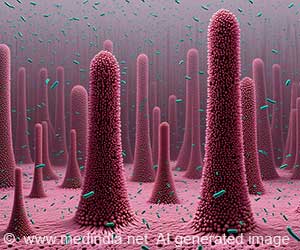Vertical transmission of microbes from mother to child were confirmed using shotgun metagenomics, showing distinct microbes between mother and infant.
Highlights
- The vertical transmission of microbiome from mother to child was studied using shotgun metagenomics sequencing
- It was found that infants shared same strains of bacteria with their mothers, confirming vertical transmission of microbes.
- One infant had Bifidobacterium bifidum strain which was 99.96% identical with the strain present in the mother.
Evidence of Transmission
There were several bacterial strains that were identical, both in the mother as well as in infants which were distinct when compared to the microbes found in other mothers or infants. This was strong evidence in support of vertical transmission.TOP INSIGHT
Gut microflora transmitted from mother to child will aid in healthy microbiome. Novel technology identifies vertical transmission of microbes.
Important for a Healthy Microbiome
Assistant professor at the Centre for Integrative Biology, Dr. Nicola Segata who is the senior author of the study said that early exposure of infants to gut microbiome was vital for the acquisition and a healthy microbiome. The research team under Dr. Nicola devised methods that identified the vertical transmission of microorganisms from mothers to their infants, showing that mothers were sources of microbes which were vital for the development of healthy infant gut microbiome.Studies that were conducted earlier showed that the species of microbes were the same in both the mothers as well as infants but as these studies were cultivation free, the exact strain of the microbes could not be ascertained. Dr. Adrian Tett who was the co-senior author of the study concluded that unless the microbes were found to be the same strain or the same genetic variant, it would be difficult to ascertain if they were obtained through vertical transmission.
Infant Gut or the Womb?
The exact stage at which colonization of microbes occurs has been the topic of debate among scientists, whether it occurs in the infant’s gut at the time of birth or if it occurs in the womb. Dr. Segata said that if it could be found that exposure to microbiome occurs at the time of delivery then if the mother harbors an infectious strain which could harm the baby, then preventive medicine could be prescribed to avoid transmission to the infant. Current medical practices advocate the use of tests to detect Streptococcus group B strains and preventive medication is administered to avoid the transmission to the new born infant.Identifying Vertical Transmission
The study included 5 mother and baby pairs who were recruited from a hospital when the infants were three months old. Fecal and breast milk samples were collected. Additional samples were collected from two of the mother- infant pairs when the infants were about 10-months-old and from another pair when the infant was about 16-months-old.The study found that
- The intestines of the mothers showed greater microbial diversity, which was expected.
- The gut microbiome analysis of the 16-month-old infants showed that the diversity of the gut microbiome was by now more like the mother.
- Samples of breast milk showed limited diversity when they were collected soon after birth.
- Microbes that are normally found in the skin were found only in small numbers in the gut of infants showing that skin microbes do not normally colonize in the gut of humans.
Analyzing Microbial Transmission
The metagenomic samples were further analyzed to understand the strains of bacteria that were present using computational techniques that were newly developed. The results of this part of the study were:- One infant carried Bifidobacterium bifidum strain which was 99.96% identical to the mother's strain but which was different from the strains found in the other infants.
- Ruminococcus bromii and Coprococcus were found in another infant and which was over 99% identical with the mother's.
Advantages of the Microbiome in Humans
There are numerous microorganisms in the body and it is estimated that the genes present in these organisms are more than those in the human genome. The metabolic activities that are carried out by the gut microflora have resulted in them being called a ‘forgotten’ organ.Microorganisms aid in
- Fermenting unused energy substrates
- Preventing harmful bacteria from colonizing
- Preparing the immune system
- Regulating the gut development
- Producing vitamins like vitamin K and biotin which can be utilized by the host
The current study that focuses on the presence of vertical transmission between mother and child will aid in understanding the benefits of a normal delivery and the healthy microbial environment which could be passed on.
References:
- Cesarean versus Vaginal Delivery: Long term infant outcomes and the Hygiene Hypothesis - (https://www.ncbi.nlm.nih.gov/pmc/articles/PMC3110651/)
 MEDINDIA
MEDINDIA




 Email
Email





